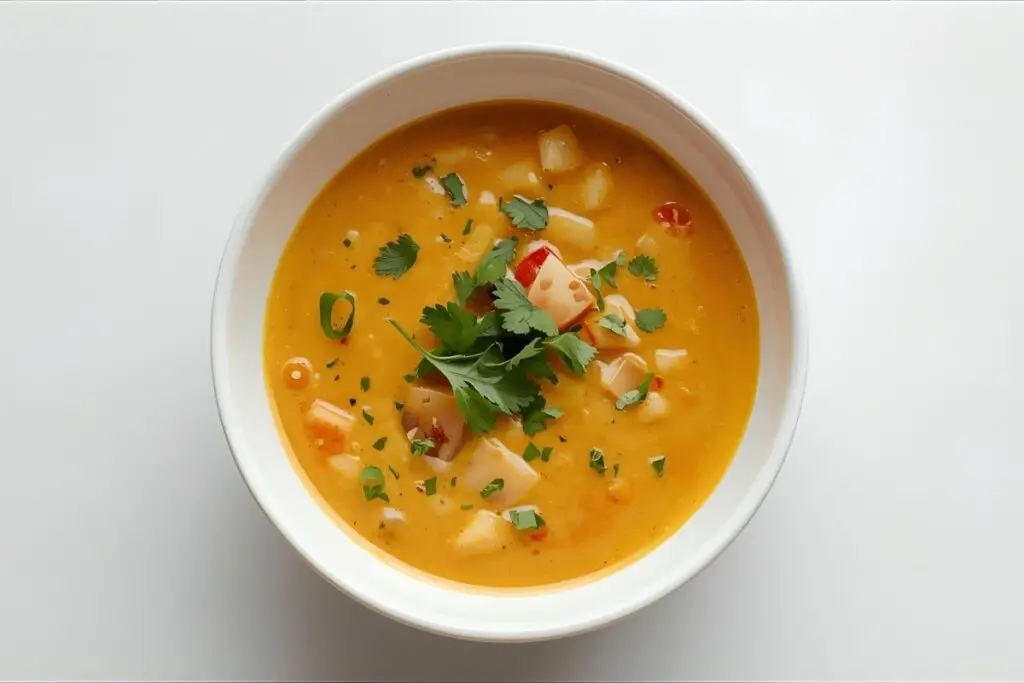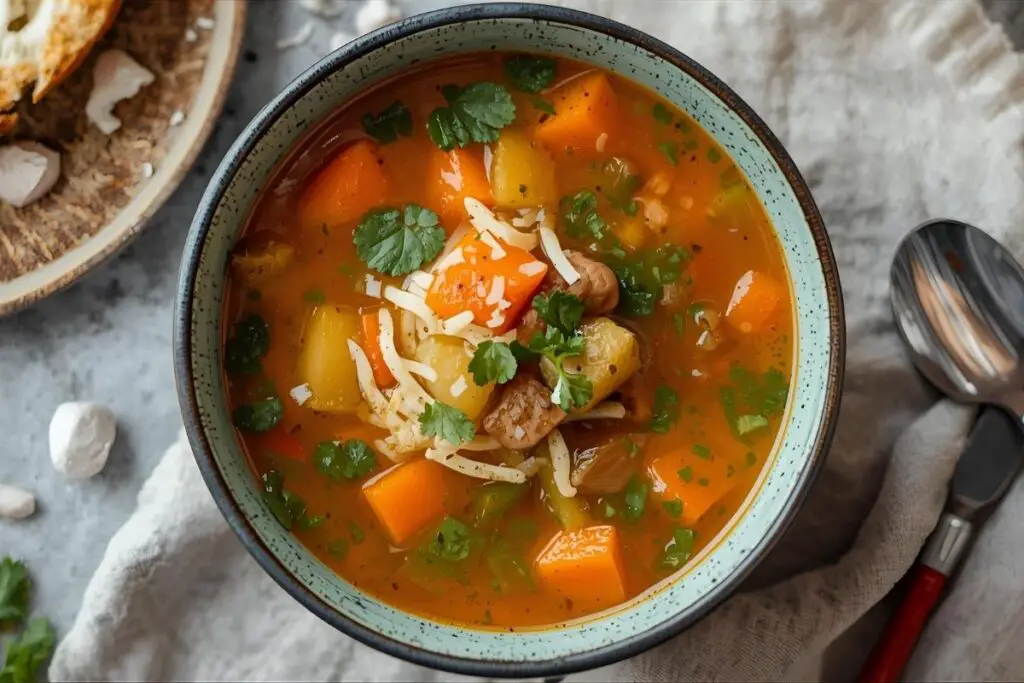Table of content
Table of Contents
Introduction

If you’re craving flavorful meals that support your health goals, high protein low carb soup recipes offer an ideal solution. Packed with essential nutrients, these soups can be both satisfying and slimming, making them perfect for anyone following a low-carb or ketogenic lifestyle. Unlike traditional soups loaded with starchy fillers, high protein low carb soups prioritize nutrient-dense ingredients that keep you full longer without the carb crash. Whether you’re meal prepping for the week or looking for a quick dinner option, these soups provide comfort without compromising your macros. Ready to discover some easy recipes and practical tips? Let’s dive into delicious, protein-rich, low carb soups that you can enjoy any day.
Ingredients List
Creating a high protein low carb soup relies on selecting the right ingredients that balance taste and nutrition. The key protein sources include lean meats like chicken breast, turkey, or ground beef, but seafood such as shrimp or white fish also work wonderfully. For plant-based options, tofu, tempeh, or edamame provide excellent protein while keeping carbs in check.
Vegetables play a vital role as well; think leafy greens like spinach and kale, zucchini, cauliflower, and mushrooms—these add bulk and fiber with minimal carbs. Avoid starchy vegetables like potatoes and carrots, or use them sparingly. Aromatics such as garlic, onion, and fresh herbs like thyme or rosemary bring depth to your soup without sugar spikes.
To add creaminess without heavy carbs, consider unsweetened almond milk, coconut milk, or Greek yogurt (added off the heat to prevent curdling). Bone broth or low sodium chicken broth are perfect bases, delivering extra protein and minerals.
Substitutions: If you’re allergic or want variety, swap chicken for turkey or tofu for meat. Use different herbs for unique flavor profiles—cumin for warmth or dill for freshness. Avoid canned soups with hidden sugars and preservatives to keep your meal clean and healthy.
Timing
Preparing this soup is straightforward and perfect for meal prep. The total time is about 45 minutes from start to finish. Prep time takes around 15 minutes, including chopping vegetables and measuring ingredients. Cooking time is roughly 30 minutes to ensure the flavors meld and proteins cook through completely. You can double or triple the batch, storing portions for quick reheats throughout the week, making it a time-efficient choice with lasting benefits.
Step-by-Step Instructions
Print
High protein low carb soup
- Total Time: 45 mins
- Yield: 4 servings
Ingredients
- Olive oil (1 tablespoon)
- Garlic (2 cloves, minced)
- Onion (1 medium, diced)
- Fresh herbs (1 tablespoon, chopped – thyme, rosemary, or dill)
- Chicken breast or turkey (1 lb, diced) or tofu/shrimp as substitute
- Zucchini (1 medium, diced)
- Mushrooms (1 cup, sliced)
- Spinach or kale (2 cups, chopped)
- Bone broth or low sodium chicken broth (4 cups)
- Unsweetened almond milk or coconut milk (½ cup, optional for creaminess)
- Salt (to taste)
- Black pepper (½ teaspoon)
- Smoked paprika or cayenne (½ teaspoon, optional for spice)
- Greek yogurt (¼ cup, optional garnish)
- Fresh parsley or chives (2 tablespoons, chopped, for garnish)
- Prep Time: 15 mins
- Cook Time: 30 mins
- Category: High Protein Meals
- Method: Stovetop
- Cuisine: American
Step 1: Prepare and Sauté the Aromatics
Start by finely chopping garlic, onion, and your choice of fresh herbs. Heat a tablespoon of olive oil in a large pot over medium heat, then add the aromatics. Sauté until fragrant and translucent, about 3-5 minutes. This step builds a deep flavor base. Avoid browning the garlic too much, which can introduce bitterness; gentle cooking preserves its sweetness.
Step 2: Add the Protein
Add your protein choice next—diced chicken breast or crumbled ground turkey, for example. Cook until browned on all sides, about 5-7 minutes. Stir frequently to ensure even cooking. If using seafood, add it later in the process to prevent overcooking. For plant-based proteins like tofu, press to remove excess moisture before adding.
Step 3: Incorporate Vegetables and Broth
Once the protein is browned, add your chopped vegetables—zucchini, spinach, mushrooms—and stir well. Pour in the bone broth or low sodium broth, bringing everything to a gentle boil. Lower heat to simmer and cook for about 15-20 minutes until vegetables soften but still retain structure. For added creaminess, stir in coconut milk or almond milk during the last five minutes.
Step 4: Season and Thicken
Season the soup with salt, pepper, and spices like smoked paprika or cayenne for a mild kick. If you want to thicken the soup without carbs, blend a portion of the soup with an immersion blender, then stir it back in. This technique enhances mouthfeel without resorting to flour or starchy thickeners. Avoid boiling aggressively, which can break down protein and impact texture.
Step 5: Serve and Garnish
Ladle the soup into bowls and garnish with fresh herbs like parsley or chives. Add a dollop of Greek yogurt or a sprinkle of shredded cheese if desired. Serve warm with a side of leafy green salad or steamed asparagus to complete your low carb meal. Soup tastes best fresh but also improves after sitting a few hours as flavors meld.
Nutritional Information
Each serving of high protein low carb soup contains approximately 300-350 calories, 35-40 grams of protein, 6-8 grams of carbohydrates, and 10-12 grams of healthy fats. The low carb count supports steady blood sugar levels and complements ketogenic or low-carb diets. High protein content aids muscle repair, supports weight management by promoting satiety, and boosts metabolic rate. Including fibrous vegetables in the soup adds essential vitamins and minerals, aids digestion, and enhances gut health, making this soup both a nutritious and delicious meal option.
Healthier Alternatives for the Recipe
Consider these variations to keep your soups fresh and tailored to dietary needs:
Vegetarian High Protein Soup: Use lentils or split peas with tofu to maintain protein while lowering fat. Avoid cream by blending cooked cauliflower for smoothness.
Seafood Protein Boost: Swap chicken with shrimp or white fish to add omega-3 fatty acids. Use fish broth instead of chicken broth for added ocean flavor.
Creamier Coconut Version: Increase coconut milk and add lemongrass or ginger for an Asian-inspired twist. Use turmeric for anti-inflammatory benefits.
Spicy Chili Soup: Incorporate diced green chiles, jalapeños, and chili powder for heat. Opt for lean ground turkey for a protein-rich punch.
Each alternative caters to personal preferences, dietary restrictions, or flavor adventures while keeping macros optimal.
Serving Suggestions

High protein low carb soups pair wonderfully with fresh, crunchy salads or steamed, non-starchy vegetables like broccoli or green beans. In colder months, serve with a sprinkle of pumpkin seeds or sliced avocado on top to add extra nutrients and texture. For a cultural twist, garnish with fresh cilantro and a squeeze of lime for a Mexican-inspired touch or toasted coconut flakes for Thai flavors. Seasonal pairings include adding spring peas and asparagus in springtime or hearty kale and mushrooms in fall. These soups are versatile and can accompany almost any low-carb side, making them excellent year-round meal options.
Common Mistakes to Avoid
Overcooking vegetables: Leads to mushy textures; keep veggies crisp by simmering gently and in limited time.
Using high-sodium broth: Can make soups overly salty; opt for low sodium versions or homemade broth.
Skipping proper protein prep: Avoid soggy texture by properly searing meats and pressing tofu.
Ignoring seasoning layers: Season in stages (during sautéing, after broth addition) for balanced flavor.
Over-thickening with starches: Keeps the carb count low by using pureed vegetables instead of flour or cornstarch.
Correcting these ensures a satisfying and nutritious soup every time.
Storing Tips for the Recipe
Store high protein low carb soups in airtight containers in the refrigerator for up to 4 days. For longer storage, portion the soup into freezer-safe containers and freeze for up to 3 months. When reheating, thaw overnight and warm gently on the stovetop or microwave, stirring occasionally to prevent scorching. Avoid reheating multiple times to preserve texture and flavor. Meal prepping with this soup is a breeze: prepare a large batch, portion it into grab-and-go containers, and enjoy healthy, macro-friendly meals all week long.
Conclusion
High protein low carb soup recipes are the perfect balance of flavor, nutrition, and convenience. Offering rich protein content combined with low carbohydrate vegetables, these soups keep you feeling full and energized without the carb overload. Ideal for meal prep or last-minute dinners, they suit a variety of diets and taste preferences. If you’re ready to dive deeper into nutritious, satisfying meals, check out our collection of healthy soups on TrickRecipe, where you’ll find even more delicious, macro-friendly ideas. For further reading on the benefits of high protein low carb diets, visit Healthline’s comprehensive guide. Give these soups a try today and experience wholesome, flavorful nourishment.
FAQs
Q: Can I use frozen vegetables in this soup?
Yes, frozen veggies are a convenient option and retain most nutrients. Just add them a few minutes earlier in the cooking process to ensure they’re heated through without becoming mushy.
Q: What are the best protein options for low carb soups?
Lean meats like chicken breast, turkey, seafood, tofu, and legumes like lentils are great low carb, high protein choices that stay within dietary macros.
Q: How can I thicken the soup without adding carbs?
Using an immersion blender to puree part of the soup creates natural thickening. You can also add mashed cauliflower or cream cheese for texture without raising carbs.
Q: Is it okay to add dairy like cheese or yogurt?
Yes, as long as you use full-fat, low sugar options, adding cheese or yogurt off the heat can add creaminess and flavor while keeping carbs low.
Q: How long does this soup keep in the fridge?
Stored in an airtight container, it stays fresh for up to 4 days. For longer storage, freeze in portions for up to 3 months.
